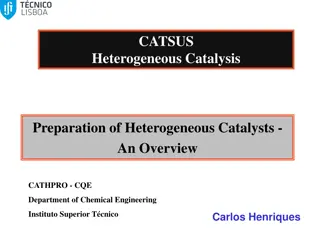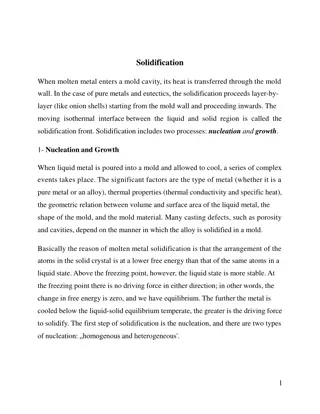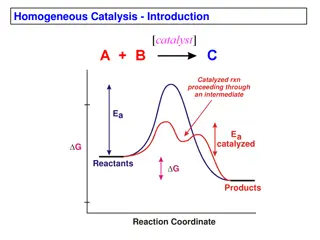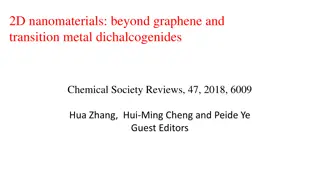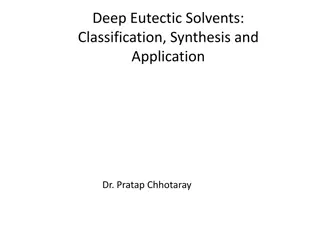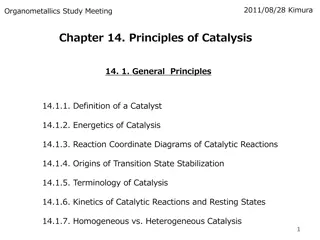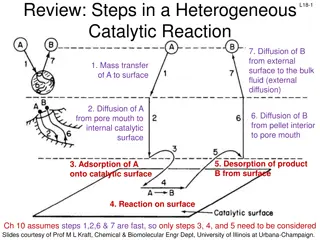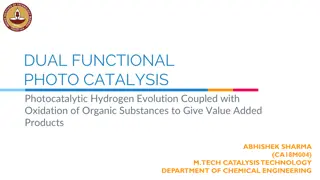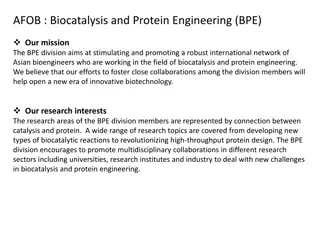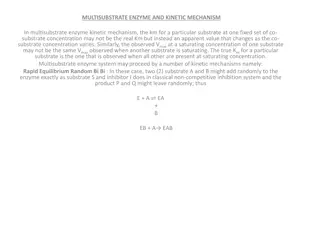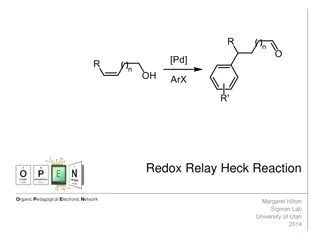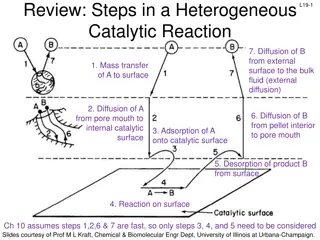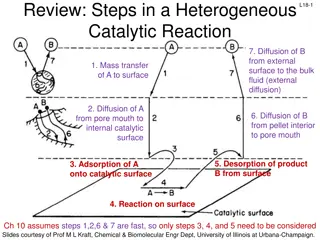Adaptive Tree-based Convergecast Protocol
Adaptive tree-based protocol for managing overlay networks in heterogeneous networks. It proposes improvements to the existing Tree-Based Convergecast Routing (TBCR) protocol by considering additional parameters such as RTT, power consumption, link stability, and link mobility to optimize routing de
32 views • 12 slides
Semi-Supervised Credit Card Fraud Detection via Attribute-Driven Graph Representation
Explore a novel approach for detecting credit card fraud using a semi-supervised attribute-driven graph representation. The technique leverages temporal aggregation and attention layers to automatically unify heterogeneous categorical attributes and detect fraudulent transactions without label leaka
1 views • 23 slides
Understanding Enzyme Function Through Induced Fit Model
The learning content discusses enzymes as biological catalysts that increase reaction rates by lowering activation energy. It explores how enzyme activity efficiency is influenced by factors such as temperature, pH, and substrate concentration. The Induced Fit Model is analyzed to explain how enzyme
5 views • 12 slides
Organometallic Chemistry III: Transition Metal Complexes and Homogeneous Catalysis
Explore the reactivity of transition metal complexes, including bond metatheses and various reactions. Learn about orbital considerations, synthesis, and spectroscopic properties of organometallic complexes. The course covers basics from AC1, focusing on ligands, electron counting, and MO diagrams.
5 views • 8 slides
Overview of Heterogeneous Catalysis and Catalyst Preparation
The development of catalytic processes involves research and development of new catalysts for better activity, selectivity, and stability. This study focuses on preparing new catalysts, determining their properties, and optimizing their development through structure-reactivity relationships. Catalys
5 views • 17 slides
Effective Strategies for Rural Marketing and Promotion
Evolving effective strategies for rural marketing involves segmentation of the heterogeneous rural market, identification of different segment needs, and formulating marketing mix strategies related to product, price, place, and promotion. Product strategies include small unit packaging and new desi
1 views • 44 slides
Understanding Solidification Process in Metal Casting
Solidification in metal casting involves nucleation and growth processes, impacting the final product's quality. Factors such as type of metal, thermal properties, and mold shape influence solidification. Homogeneous nucleation occurs below the equilibrium freezing point, while heterogeneous nucleat
1 views • 8 slides
Understanding Thermal Bridges in Building Design
The concept of thermal bridges in buildings is explored, focusing on heat transfer, evaluation assumptions, heterogeneous wall elements, deviations from one-dimensional flow, and thermal bridge zones. Practical implications for building design and energy efficiency are discussed.
6 views • 82 slides
Understanding the Importance of Phospholipids in Physiology
This educational material delves into the significance of phospholipids in physiological processes. Topics covered include the structure and functions of phospholipids, their role in membranes, signaling mechanisms, and non-membrane functions. The content also explores lipid compounds as a heterogen
0 views • 25 slides
Principles of Green Chemistry: Catalysis and Bio-Catalysis
The 9th Principle of Green Chemistry emphasizes the use of catalysis to improve reaction efficiency and reduce waste generation. Catalytic reagents enhance selectivity, reduce energy consumption, and minimize the need for stoichiometric reagents. Green catalysis, especially bio-catalysis using enzym
0 views • 25 slides
Factors Affecting Enzyme Activity and Catalysis
Enzyme activity is influenced by various factors such as enzyme concentration, temperature, pH, substrate concentration, inhibitors, activators, and physical agents. The rate of enzyme-catalyzed reactions is directly proportional to enzyme concentration, and temperature plays a significant role with
0 views • 23 slides
Understanding Enzyme Function: The Key Steps and Importance of Cofactors
Enzymes play a crucial role in catalyzing biochemical reactions by forming enzyme-substrate complexes and facilitating changes in substrate molecules to product molecules. The process involves four steps: proximity of enzyme and substrate, binding at the active site, catalysis leading to substrate a
0 views • 39 slides
Understanding Fluid Mixing in Chemical Reactions
The problems associated with fluid mixing during reactions are crucial for fast reactions in both homogeneous and heterogeneous systems. These issues involve the degree of segregation of the fluid and the timing of mixing. Concepts like RTD are intertwined with fluid mixing, affecting the behavior o
1 views • 46 slides
Understanding Colloids and Their Importance in Pharmaceuticals
Colloids play a vital role in the pharmaceutical industry as heterogeneous biphasic systems with particle sizes ranging from 1nm to 100nm. They are classified based on aggregation and interaction of phases, with examples like aerosols, foams, emulsions, and more. Colloids can be prepared by condensa
0 views • 23 slides
Understanding Remote Method Invocation (RMI) in Distributed Systems
A distributed system involves software components on different computers communicating through message passing to achieve common goals. Organized with middleware like RMI, it allows for interactions across heterogeneous networks. RMI facilitates building distributed Java systems by enabling method i
1 views • 47 slides
Introduction to Chemical Thermodynamics: Systems and Properties
Chemical thermodynamics explores energy changes in chemical reactions. It includes terms like system, surroundings, and boundaries. Systems can be isolated, closed, or open, each with distinct characteristics. Homogeneous and heterogeneous systems have different compositions. Properties in a system
0 views • 20 slides
Understanding Enzyme Catalysis and Active Site Role
Enzymes play a crucial role in catalyzing biochemical reactions by stabilizing transition states through their active sites. Different mechanisms like acid-base, covalent, metal, and electrostatic interactions are employed for stabilization. Acid-base catalysis involves acceleration without being co
1 views • 21 slides
Understanding Homogeneous Catalysis and Its Advantages
Homogeneous catalysis involves catalyzed reactions proceeding through an intermediate with lower activation energy. This method offers advantages such as selectivity, activity, ease of study, and modification but can be sensitive to deactivation. Comparing with heterogeneous catalysts prevalent in i
1 views • 14 slides
Advancements in 2D Nanomaterials Research
Advancements in the field of 2D nanomaterials, beyond graphene and transition metal dichalcogenides (TMDs), have attracted significant attention. Researchers explore various 2D materials with unique properties and applications. The categorization of 2D materials into layered and non-layered structur
0 views • 21 slides
Inorganic Pharmaceutical Chemistry: Applications and Importance
Inorganic pharmaceutical chemistry explores the study of elements and compounds excluding carbon, with diverse applications in pharmacy. It encompasses the synthesis and use of inorganic compounds in drug development, catalysis, pigments, and agriculture. The field also delves into the medicinal val
1 views • 6 slides
Deep Eutectic Solvents: Classification, Synthesis, and Applications
Deep Eutectic Solvents (DES) are versatile solvents formed by mixing specific acids and bases. These solvents exhibit unique hydrogen bonding properties, resulting in a lower melting point compared to individual components. DES can be classified into hydrophobic and hydrophilic types, each with dist
3 views • 7 slides
Advances in sp3C-H Activation Catalyzed by Palladium - Bo Yao
Recent progress in the field of sp3C-H activation catalyzed by palladium has led to significant insights and challenges. Concepts related to C-H activation, strategies employed, and identified obstacles are discussed, highlighting the importance of this area in catalysis research.
0 views • 15 slides
Fundamentals of Asymmetric Catalysis: Energetics and Principles
Exploring the principles and energetics of asymmetric catalysis, this study delves into the importance, classes of transformations, stereoselectivity, and transmission of asymmetry. It discusses reaction coordination diagrams, transition state stabilization, and the terminology of catalysis. The Cur
2 views • 20 slides
Understanding Heterogeneous Catalytic Reactions: Key Steps Explained
In a heterogeneous catalytic reaction, various important steps occur, including diffusion of reactants, adsorption onto the catalyst surface, surface reactions, and desorption of products. Different mechanisms like single-site, dual-site, and Eley-Rideal mechanisms are involved in the surface reacti
0 views • 17 slides
Biology Review: Genetics, Enzymes, and Cell Division
Explore key concepts in AP Biology, including genetic continuity and change, enzyme catalysis, mitosis, and meiosis. Understand the mechanisms of genetic variability and cell division processes. Dive into enzyme-substrate interactions and the differences between mitosis and meiosis.
0 views • 11 slides
Renormalization Group Analysis of Magnetic Catalysis in Quantum Field Theories
Explore the phenomenon of magnetic catalysis in strong magnetic fields through a renormalization group analysis, drawing parallels to superconductivity and dimensional reduction. Discuss the impact of IR dynamics on nonperturbative physics like superconductivity. Delve into Landau-level quantization
0 views • 21 slides
Dynamic Core Boosting for Heterogeneous Computing
Exploring the challenges of workload heterogeneity in parallel programming, focusing on the impact of asymmetric hardware on performance and synchronization. Insights on modeling workload imbalance and boosting critical paths for efficient computation in heterogeneous multicores.
0 views • 22 slides
Dual-Functional Photo Catalysis: Hydrogen Evolution & Organic Oxidation
The research explores dual-functional photo catalysis, combining hydrogen evolution with the oxidation of organic substances to produce value-added products. It focuses on utilizing photoelectricity to create electrons for hydrogen production and organic molecule oxidation. The study investigates th
0 views • 14 slides
Asian Bioengineers Network for Biocatalysis and Protein Engineering
The Biocatalysis and Protein Engineering (BPE) division of AFOB aims to build a strong international network of Asian bioengineers working in biocatalysis and protein engineering. Their research areas span catalysis and protein connections, from developing new biocatalytic reactions to high-throughp
0 views • 4 slides
Understanding Multisubstrate Enzyme Kinetic Mechanisms
In multisubstrate enzyme kinetic mechanisms, the apparent Km and Vmax values change with varying substrate concentrations. Different kinetic mechanisms like rapid equilibrium Bi Bi and ordered Bi Bi reactions can occur. The ping-pong Bi Bi reaction involves oscillation between enzyme forms. Various
0 views • 11 slides
Understanding Rate Expressions in Heterogeneous Systems
In heterogeneous systems, the rate expression involves mass transfer terms alongside chemical kinetics terms due to the presence of multiple phases. Different types of heterogeneous systems have varying mass transfer complexities, making a general rate expression challenging to define. Examples such
0 views • 29 slides
Optimizing Data Center Costs with Heterogeneous-Reliability Memory
Reducing data center costs while meeting availability targets is the focus of this study on memory error vulnerabilities. By employing a heterogeneous-reliability memory approach, storing error-tolerant data in less reliable memory and error-vulnerable data in more reliable memory, significant savin
0 views • 51 slides
Understanding Mixtures: Homogeneous vs Heterogeneous and Separation Techniques
Explore the differences between homogeneous and heterogeneous mixtures, with examples like Cheerios and trail mix. Learn about mixtures like apple juice and orange juice with pulp. Discover how to separate mixtures based on their composition, whether they are homogeneous or heterogeneous, using tech
0 views • 16 slides
Utilizing Hydrotalcites as Photo Catalysts for Carbon Dioxide Reduction
Burning fossil fuels leads to CO2 emissions, posing a significant environmental challenge. Converting CO2 into valuable hydrocarbons through photocatalytic reduction using solar energy provides a sustainable solution. This process involves multi-electron transfer steps, requiring efficient catalysts
0 views • 24 slides
Understanding the Redox-Relay Heck Reaction in Organic Synthesis
The Redox-Relay Heck Reaction is a powerful tool in organic synthesis that allows for the functionalization of olefins with aryl groups. Developed by Sigman and colleagues, this reaction involves a palladium-catalyzed relay controlled by a thermodynamic sink, leading to the formation of aldehydes or
0 views • 6 slides
Understanding the Hierarchy of Protein Structure
To understand proteins' final shape and function, one must grasp the primary, secondary, tertiary, and quaternary structure levels. Proteins, composed of amino acids, fold into various shapes crucial for their roles such as signaling, catalysis, and structure. The primary structure represents the am
0 views • 28 slides
Semi-Supervised User Profiling with Heterogeneous Graph Attention Networks
Utilizing heterogeneous graph attention networks, this study addresses the limitations of existing user profiling methods by integrating multiple data types and capturing rich interactions in user data. The approach tackles critical problems in representation learning, information propagation, and m
0 views • 15 slides
Heterogeneous Transmutation of Americium in Fast Reactors: Burning for Sustainable Energy
Americium poses challenges in safe disposal due to its high radiation and volatility. However, through transmutation into other nuclides, such as 242Cm and 238Pu, it can be efficiently burned in fast reactors, offering a solution for clean energy production. Heterogeneous burning is preferred for it
0 views • 7 slides
Understanding Heterogeneous Catalytic Reactions: Steps and Mechanisms
The content discusses the key steps involved in a heterogeneous catalytic reaction, focusing on diffusion, mass transfer, adsorption, desorption, and surface reactions. It highlights the importance of considering external diffusion effects and provides guidelines for deducing reaction mechanisms in
0 views • 40 slides
Understanding Steps in Heterogeneous Catalytic Reactions and Adsorption Mechanisms
This review discusses the steps involved in a heterogeneous catalytic reaction, focusing on diffusion, mass transfer, adsorption, and desorption processes. It details the site balance, surface reaction mechanisms, and desorption steps, providing insights into the complexities of catalytic processes.
0 views • 17 slides




